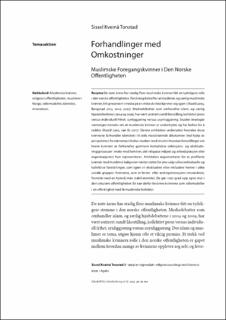| dc.contributor.author | Tonstad, Sissel Kveinå | |
| dc.date.accessioned | 2023-06-01T11:33:14Z | |
| dc.date.available | 2023-06-01T11:33:14Z | |
| dc.date.created | 2023-05-23T21:17:36Z | |
| dc.date.issued | 2023 | |
| dc.identifier.citation | Tonstad, S. K. (2023). Forhandlinger Med Omkostninger. Muslimske Foregangskvinner i Den Norske Offentligheten. Tidsskrift for islamforskning, 17(1), 83-104. | en_US |
| dc.identifier.issn | 1901-9580 | |
| dc.identifier.uri | https://hdl.handle.net/11250/3069634 | |
| dc.description.abstract | The last few years an increasing number of Muslim women have found a clear voice in the public sphere in Norway. Research into Islam confirms that Muslims, especially Muslim women, are presented in media in a way that is unrecognizable to themselves. The debates in the media surrounding Islam, especially the hijab controversy in both 2004 and 2009, have centered around gender equality, collective peer pressure vs individual freedom, and the urge to be made visible vs invisibility. This article explores how Muslim women in the public sphere in Norway negotiate identity in a partially contradictory dichotomy. Applying the perspective of theory on cultural studies, I will demonstrate how women actively negotiate autobiographical representations about who they are, through complex selection and exclusion processes when confronted with three different groups: family, the religious environment, and the workplace or organizations they represent. This implies an oppositional relationship between the different groups’ expectations of the role of Muslim women in the public sphere. This article argues that when confronted with oppositional collective expectations, Muslim women find support for their choices in a variety of representations, and that the active choices she makes exclude or include her to a certain extent in the different social groups. These women, who are first- and second-generation immigrants, present with a hybrid although stable identity. To a large extent, they forge their own paths in the secular public sphere. Therefore, one can describe the women as role models in public spheres with few Muslim examples. | en_US |
| dc.language.iso | nob | en_US |
| dc.publisher | Forum for Islamforskning | en_US |
| dc.rights | Attribution-NonCommercial-NoDerivatives 4.0 Internasjonal | * |
| dc.rights.uri | http://creativecommons.org/licenses/by-nc-nd/4.0/deed.no | * |
| dc.title | Forhandlinger Med Omkostninger. Muslimske Foregangskvinner i Den Norske Offentligheten. | en_US |
| dc.type | Peer reviewed | en_US |
| dc.type | Journal article | en_US |
| dc.description.version | publishedVersion | en_US |
| dc.rights.holder | © 2023 The Author(s) | en_US |
| dc.subject.nsi | VDP::Humaniora: 000::Teologi og religionsvitenskap: 150::Religionsvitenskap, religionshistorie: 153 | en_US |
| dc.subject.nsi | VDP::Samfunnsvitenskap: 200 | en_US |
| dc.source.pagenumber | 83-104 | en_US |
| dc.source.volume | 17 | en_US |
| dc.source.journal | Tidsskrift for islamforskning | en_US |
| dc.source.issue | 1 | en_US |
| dc.identifier.doi | https://doi.org/10.7146/tifo.v17i1.137362 | |
| dc.identifier.cristin | 2148872 | |
| cristin.qualitycode | 1 | |

